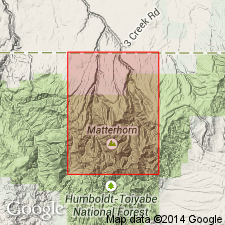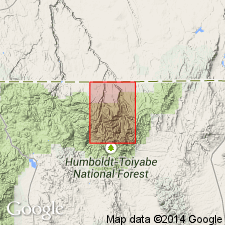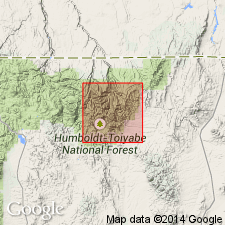
- Usage in publication:
-
- Gods Pocket dacite*
- Modifications:
-
- [First used]
- Dominant lithology:
-
- Dacite
- AAPG geologic province:
-
- Great Basin province
Summary:
Pg. 306. Gods Pocket dacite. Sequence of dacite flow material about 700 feet thick. Disconformably overlies Jarbidge rhyolite (new) and locally separated from it by 30 to 50 feet of pale-gray vitric tuff. Present in northeastern quarter Jarbidge quadrangle, Elko Co., northeastern NV. Gods Pocket Dacite adopted by the USGS.
USGS currently [ca. 1966] considers the Gods Pocket Dacite to be Pliocene(?) in age.
Source: US geologic names lexicon (USGS Bull. 1200, p. 1534).

- Usage in publication:
-
- Gods Pocket dacite*
- Modifications:
-
- Named
- Dominant lithology:
-
- Dacite
- AAPG geologic province:
-
- Great Basin province
Summary:
Gods Pocket dacite. Sequence of pale-gray, dense, stony, aphanitic dacite flows and minor tuffs. Locally includes black vitrophyric phases, and at base, a 30- to 50-foot unconsolidated pale-gray vitric tuff. Contains relatively large phenocrysts of andesine and lesser amounts of sanidine, smaller and sparser phenocrysts of quartz and pigeonite, and rare augite and hypersthene; accessory minerals include magnetite, apatite, and zircon. Thickness about 930 feet, however, top of unit is absent. Unconformably overlies Jarbidge rhyolite (new); unconformably underlies Pole Creek dacite (new) and Slide Creek gravel (new). Source is unknown, though vent may lie beneath Gods Pocket Peak. Age is considered Pliocene(?), based on stratigraphic position; possibly Miocene -or- Miocene and Pliocene (D.I. Axelrod, written commun., 1959). Report includes geologic map. Adopted by the USGS.
Type locality: Gods Pocket Peak in southeast part of Jarbidge quadrangle, Elko Co., northeastern NV. Named from Gods Pocket Peak.
Source: Modified from GNU records (USGS DDS-6; Denver GNULEX).

- Usage in publication:
-
- Gods Pocket Dacite*
- Modifications:
-
- Age modified
- AAPG geologic province:
-
- Great Basin province
Summary:
Age modified from Pliocene? to late Miocene in Jarbidge Wilderness and adjacent areas, north-central Elko Co, NV, Great Basin province. Age change based on 12.2 +/-0.8 m.y. date on Cougar Point Welded Tuff from Owyhee quad about 40 mi to west by Obradovich (Coats, Stephens, 1968, Ore deposits of the United States, 1933-1967, v. 2, p. 1083). Thus all rocks older than Cougar Point and younger than Jarbidge Rhyolite (Gods Pocket, Pole Creek Dacite, Slide Creek Gravel and Jenny Creek Tuff) are assigned late Miocene age.
Source: GNU records (USGS DDS-6; Denver GNULEX).
For more information, please contact Nancy Stamm, Geologic Names Committee Secretary.
Asterisk (*) indicates published by U.S. Geological Survey authors.
"No current usage" (†) implies that a name has been abandoned or has fallen into disuse. Former usage and, if known, replacement name given in parentheses ( ).
Slash (/) indicates name conflicts with nomenclatural guidelines (CSN, 1933; ACSN, 1961, 1970; NACSN, 1983, 2005, 2021). May be explained within brackets ([ ]).

